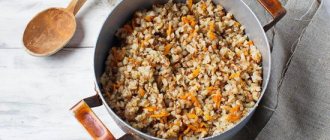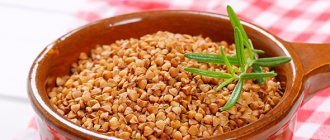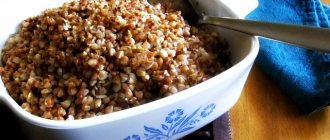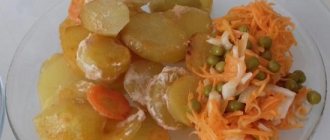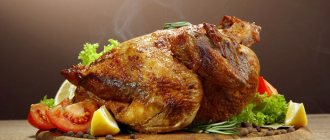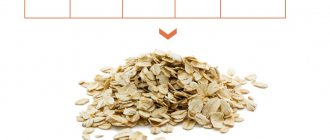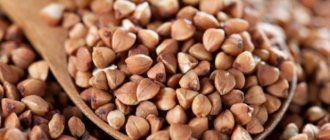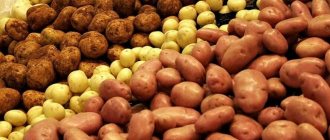Oatmeal is a traditional English breakfast that has successfully caught on among Russians. It is usually prepared with milk, but adherents of a healthy diet prefer recipes with water. It occupies a leading position among the entire variety of cereals in terms of nutritional and energy value. And its low calorie content allows it to be considered a dietary dish.
When you eat oatmeal in the morning, you feel quickly and long-lasting, and the dish gives you energy for the whole day. For taste, fruits, berries, honey, sugar, nuts and other ingredients are added to it.
The benefits and harms of oatmeal
Oatmeal takes a leading place in the amount of substances beneficial to the human body. It contains magnesium, manganese, potassium, iron, vitamins A, B1, B2, B2, B3, B5, B6, B9, E, D, a lot of fiber, as well as easily digestible vegetable protein.
Useful properties of oatmeal:
- Keeps you full for a long time, helping to avoid unwanted snacks and spikes in blood sugar levels.
- Improves skin condition, eliminates swelling and inflammation.
- Activates the growth and strengthening of muscle mass.
- Helps cleanse the intestines of accumulated harmful substances.
- Reduces the risk of pathologies of the cardiovascular system.
Photo source: shutterstock.com
Despite all the benefits of oatmeal, eating it every day is not recommended. The fact is that this porridge contains phytic acid, which binds organic calcium compounds and prevents its normal absorption in the intestines. It is better to alternate oatmeal with other types of porridge (barley, buckwheat, rice, etc.).
Porridge - benefits of the product for the body
In addition to its nutritional properties, each porridge has a beneficial effect on the general physical condition of a person. One of the most useful is buckwheat. Along with it, the necessary substances enter the body. Buckwheat normalizes blood pressure and removes excess cholesterol.
A small amount of buckwheat porridge causes satiety, which is why it is consumed when losing weight.
Rice porridge is suitable for a low-calorie diet, as it maintains body tone for a long time. Oatmeal is a source of nutrients and a medicine for the gastrointestinal system. Fiber, which oatmeal is rich in, cleanses the body. All cereals are healthy, each in its own way.
Calorie content of oatmeal per 100 grams
As is known, the energy value of the original product can differ significantly from the calorie content of the finished dish. Oatmeal was no exception.
Photo source: shutterstock.com
The calorie content of dry cereal per 100 grams is 316 kcal. The BZHU indicators are as follows:
- proteins - 11.82 g;
- fats - 5.8 g;
- carbohydrates - 59 gr.
But even the most desperate will not chew dry oatmeal. Therefore, let's find out how many calories are in the finished porridge with various variations of cooking.
How many calories are in oatmeal porridge “Clear Sun No. 2”
In its raw form, the calorie content of Yasno Solnyshko No. 2 oatmeal is 360 kcal per 100 grams of product, and in boiled form it is only 88 kcal. The nutritional value of the finished porridge with water without additives is: 3 g / 1.70 g / 15 g.
How calories increase with supplements
The final energy value of any porridge is influenced not so much by what it was cooked with, but by what was put into it to improve its taste. With abundant flavoring with various additives, even the lowest-calorie cereal will turn from a dietary dish into a dessert or culinary delight with all the ensuing consequences for the waist. Even the addition of such a seemingly harmless spice as salt can greatly harm the dietary properties of cereals. If you often overdo it with its quantity, this will lead to the fact that water metabolism in the human body will be disrupted, which will be reflected in the appearance of swelling. And although salt does not add calories to dishes, it slows down metabolism, which will be more serious than the problem with the increased calorie content of the product.
But sugar directly affects energy value, as well as the amount of carbohydrates. A person who wants to lose weight must carefully calculate his daily diet so that it is as complete as possible. This means that the amount of proteins, fats and carbohydrates per day should be strictly fixed depending on the personal characteristics of a person (weight, age, height, physique, gender, and so on). In this case, you will have to reduce as much as possible the amount of sugar, which contains a large amount of fast carbohydrates. And if in terms of caloric content one teaspoon of sugar contains 32 kcal, then it contains 10 grams of carbohydrates, which can be a decisive factor for creating a menu for the day. In addition, the effect of fast carbohydrates is fleeting, which means that after half an hour you will again want to sweeten your life with dessert.
Oil has a strong effect on the calorie content of boiled cereal. For example, one teaspoon of sunflower oil will add 45 calories to any porridge, and a tablespoon - all 180. Butter will add a pleasant delicate flavor to the dish, as well as extra calories: a teaspoon - 112.5 kcal, a tablespoon - 300 kcal. And the range of additives that can be added to these side dishes is far from limited. Milk porridges are often flavored with various spices and decorated with dried fruits, and cereals cooked in water are made more tasty thanks to spicy sauces.
Advice from nutritionist Irina Shilina Healthy eating is incompatible with strict dietary restrictions, malnutrition and prolonged fasting. Today there is no need to strive for abnormal thinness by depriving yourself of food! Check out the latest weight loss techniques for 2022. Find out the secret ->
Popular supplements and their calorie content
| Name | Kcal/100 g |
| Soy sauce | 50 |
| Tomato | 100 |
| Sour cream and garlic | 205 |
| Cinnamon | 245 |
| Ground black pepper | 255 |
| Saffron | 310 |
| Cardamom | 315 |
| Dried apricots | 232 |
| Peanut | 551 |
| Dried bananas | 96 |
| Walnut | 656 |
| Dried pear | 250 |
| Raisin | 265 |
Fans add other ingredients to porridge. These are a variety of nuts: pine nuts (calorie content 675 kcal/100 g), roasted cashews (535 kcal), sweet almonds (610). The following seeds are good in this regard: flaxseed (534), pumpkin (556), sunflower (601). Dried ingredients improve the taste: apples (253), figs (257), mango (314); as well as dried cranberries (308), dates (292), prunes (256), pineapple (92) or candied oranges (301 kcal).
But few people limit themselves to just one additional ingredient, and in the end the picture may look like this. If you add sugar and butter to the initially rather modest millet porridge, its calorie content will exceed 215 kcal. The same dish with dried apricots will have an energy value of 270 kcal. And semolina porridge, cooked in milk with the addition of sugar and butter, will add almost three hundred calories! A serving of peas with a tablespoon of vegetable oil added will have a calorie content of about 140 kcal, and with fried onions it will add 170 kcal.
To understand how serious damage a particular ingredient can cause to your daily diet, you need to find out its calorie content per 100 grams and determine the indicator for the amount that you plan to add to the dish.
How many calories are in 100 grams of ready-made oatmeal with additives?
When compiling a diet and counting the total number of calories, you should understand that the energy value of oatmeal depends on the additives used. After all, the calorie content of dry oatmeal and the finished product with honey, butter or milk differs by the same 100 grams.
Photo source: shutterstock.com
Oatmeal on water: calorie content
Without additives
Oatmeal without sugar, butter and honey contains only 68 kcal per 100 grams of product. BJU indicators: 2.30 g / 1.12 g / 12.64 g.
With sugar
The energy value is 108 kcal per 100 g of product. BZHU indicators: 2.23 g / 1.10 g / 20.25 g.
Photo source: shutterstock.com
With butter
The energy value is 120 kcal per 100 g of product. BZHU indicators: 2.42 g / 5.60 g / 13.43 g.
With honey
The energy value is 99 kcal per 100 g of product. BZHU indicators: 2.35 g / 1.49 g / 18.10 g.
ABC RECOMMENDS
Calorie content of buckwheat (in water, with oil, with salt) per 100 grams
Oatmeal with milk: calorie content
Without additives
Oatmeal with milk without sugar, butter and honey contains 101 kcal per 100 grams of product. BJU indicators: 3.43 g / 3.78 g / 16.07 g.
With sugar
The energy value of oatmeal cooked with milk and sugar is 146 kcal per 100 grams of product. BZHU indicators: 3.29 g / 3.58 g / 24.10 g.
Photo source: shutterstock.com
With butter
The energy value of milk oatmeal with butter is 158 kcal per 100 g of product. BZHU indicators: 3.56 g / 7.49 g / 17 g.
About supplements
When selecting cereals for your breakfast, be sure to take into account the additives that will improve their taste. They can significantly change the indicator you need. Judge for yourself (approximate values):
- ½ tsp. cinnamon = 10 kcal;
- 1 tsp. honey = 25 kcal;
- 1 tsp. granulated sugar = 32 kcal;
- 1 tsp. raisins = 13.5 kcal;
- 1 tsp. olive oil = 89.8 kcal;
- 1 tbsp. l. chopped walnuts = 47 kcal;
- 1 tbsp. l. strawberries = 8 kcal, raspberries = 9 kcal, cranberries = 6 kcal;
- 1 tbsp. l. strawberry jam = 57 kcal, raspberry jam = 54 kcal, cherry jam = 51 kcal;
- 10 g butter = 74.8 kcal;
- 20 g of cheese = 52 kcal;
- 50 g bananas = 49 kcal, apples and cherries = 26 kcal, pears = 23 kcal;
- 50 g low-fat cottage cheese = 42 kcal;
- 100 ml of milk: 1% = 40 kcal, 2% = 45 kcal, 2.5% = 52 kcal, 3% = 58 kcal.
It’s not hard to guess that even the lowest-calorie porridge will cease to be so if you cook it in full-fat milk and add sugar, butter, nuts and fruits. For weight loss, this risks going beyond the daily caloric intake and weight gain rather than weight loss. The most dietary one will be the one cooked in water and without any additives. Yes, eating it will not be entirely pleasant, but the benefits for the body and figure will be beyond any doubt.
As for salt, it does not affect the calorie content of dishes in any way. However, it should not be abused. Its daily intake is significantly limited in the proper nutrition system, in treatment tables, and in weight loss diets. The reason is that it retains water in the tissues, disrupts the water-salt balance, and negatively affects kidney function.
Semolina
Calorie content of semolina porridge
- Semolina with milk - 98 calories.
- Semolina with water – 80 calories.
The benefits of semolina porridge
- Microelements (15).
- Vitamins (7).
Harm of semolina porridge
- May cause diarrhea (diarrhea).
- Not hypoallergenic.
- Lots of gluten.
Preparation:
- Add salt to the pan (to taste).
- Add sugar (to taste).
- Pour milk over sugar and salt.
- Bring to a boil.
- Sprinkle the cereal in a stream (with your left hand).
- Stir the porridge (with your right hand).
- When the cereal is poured into the pan, cook it for no more than a minute.
- Turn off the heat and cover with a lid.
- After fifteen minutes, add oil.
Dietary properties of oatmeal
Oatmeal is a fairly safe product, even for people with diabetes. So, its glycemic index (GI) is 43-55 units, which is considered the average among cereals. The GI is an important part of the dietary properties of oatmeal. It is not only rich in micro- and macroelements, but also does not harm the figure and health of even sick people.
Oatmeal is the most “protein” porridge of all the most popular cereals, which is the least harmful to the waist and, on the contrary, allows athletes or active people to build muscle tissue, so it is introduced into the diet of strength athletes along with buckwheat.
Oatmeal is a flattened grain that has undergone primary processing from the chaff. Rough processing of grains does not allow the porridge to be completely absorbed by the body, and since most of the grains are fiber, it does not harm the sides in any way, but, on the contrary, helps to remove from the body everything unnecessary that has accumulated over days or weeks.
Concepts of total body mass and muscle mass
There are only two ways to significantly increase body weight:
- By gaining muscle mass
- Due to fat accumulation
If you eat large amounts of cereal without doing any physical activity, most of the weight gained will come from fat.
Cereals are a source of carbohydrates, and carbohydrates are the main type of energy on which the body functions.
If you consume a lot of calories and do not burn them, they will be stored in the body as a reserve source of energy - fat.
In this case, weight gain with the help of cereals occurs mainly due to fat deposits.
In strength sports there is even such a term - “getting weight.” This means increasing body weight at any cost, even by increasing body fat. Typically, this situation occurs among powerlifters and weightlifters, when they need to suddenly move to a heavier weight category.
To cope with this task, athletes begin to deliberately eat a lot of simple carbohydrates: sweets, flour, white bread, potatoes. Naturally, they don’t forget about porridge, the consumption of which during this period they try to increase to the maximum.
In bodybuilding the situation is different.
Here the main training goal is to increase body weight by increasing muscle volume. Ideally, without the accumulation of excess fat.
Training for muscle mass requires a calorie surplus to ensure guaranteed and consistent muscle growth.
Most of the food eaten is used for muscle synthesis, and excess calories are transformed into fat.
This is an “evil” that you have to put up with during the period of increasing muscle volume.
The whole art of gaining muscle mass comes down to increasing muscle as much as possible and minimizing the inevitable accumulation of fat. To do this, it is necessary to control the quantity and quality of nutrients that come with food.
In bodybuilding, excess body fat is combated at the next stage of training - during the drying period (working for relief).
The best high-calorie cereals for weight gain
So, we've sorted out the terms. Now let’s decide which cereals are best for gaining weight.
If your goal is simply weight gain, any cereal will suit you, and in large quantities.
There is an opinion that if you are gaining weight, then you need to eat only healthy cereals . Among them:
- oatmeal
- buckwheat
- rice
- pearl barley
But those that are maximally purified from fiber and contain only easily digestible carbohydrates do not provide any benefit to the body. These are sources of “empty” calories.
But if you are going to gain weight by accumulating fat, then it doesn’t really matter what kind of porridge you use to gain it.
To gain fat weight as quickly as possible, choose the varieties of cereals and cereals that are listed above, but do not neglect semolina or wheat cereals. In the fight for extra calories, they will not be superfluous.
Season such dishes with butter, sugar (jam/honey) and milk to increase calorie content to the maximum. So to speak, with a guarantee.
Chemical composition and beneficial properties of oatmeal
Oatmeal is the most popular breakfast on the planet due to the fact that it contains a number of macroelements:
- tryptophan;
- calcium;
- iodine;
- linoleic acid;
- gland;
- arginine;
- magnesium;
- phosphorus;
- potassium
Vitamins in this product are represented by groups B, E, PP, H, in particular:
- E about 1.6 mg;
- B 1 – 0.45 mg;
- At 9 – 23 mcg;
- B 2 – 0.1 mg;
- RR – 4.6 mg;
- N – 20 mcg.
Pesticides, metal particles and even mold can be found in packaged oatmeal, which indicates improper storage, processing and transportation of raw materials. No matter how strange it may be, oatmeal grains must be sorted and washed before cooking.
Additional Ingredients
A dish made from oatmeal is easy to diversify, make it attractive and appetizing if you apply all kinds of additives to it and experiment with their proportions. Traditionally, oatmeal made with milk is made sweet. With the addition of dried fruits, nuts, seeds or candied fruits, it will become much more interesting. Fresh berries and slices of your favorite fruit will add aesthetics to the delicacy. Jam or jam will replace sugar and give a pleasant taste. Cinnamon, cream or homemade caramel will certainly be delicious. An unusual but suitable ingredient is chopped pumpkin, which is added during the cooking process.
Cooking secrets
It would seem that every housewife knows how to cook oatmeal. However, not everyone finds it truly tasty and valuable for the body. We suggest adopting some techniques for creating a morning treat:
- Whole grains provide more benefits than cereal grains. If you pre-fill uncrushed cereal with water for 2 hours, the cooking time will be reduced to 1 hour.
- If you prefer flakes, you should purchase them in packaged packs, avoiding loose ones - the chance of getting a high-quality product is much higher.
- The milk must be fresh, otherwise it will curdle during cooking.
- To prevent the porridge from burning, use a thick-bottomed saucepan or a pan with a non-stick surface. For the same reason, you should not pour milk into an already hot container and cook the dish over high heat.
- The taste is directly affected by the proportions of ingredients. For a thick consistency, use 1 part oatmeal and 2 parts milk, for a medium consistency - 1:3, for a liquid dish take the proportion 1:4.
- Large flakes take longer to cook. So, the “Extra 3” variety is removed from the stove after 5 minutes, “Extra 1” - after 15, “Hercules” is boiled for up to 20 minutes.
- You cannot take porridge to the table straight from the fire. The taste will sparkle in a new way if you let it rest in a sealed container for 5 minutes. In the case of a multicooker, set it to heating mode.
- For sweetness, it is better not to use sugar, but to use honey or maple syrup, but you should add them immediately before the meal.
- Porridge is served fresh: when the dish cools down and is reheated, it loses its taste and attractiveness.
If a milk breakfast with oatmeal is prepared correctly, it will not only pamper the taste buds of all household members without exception, but will also contribute to the health of each of them.
Is it possible to eat porridge on a diet?
Experts in the field of proper nutrition recommend eating porridge for breakfast. Cereals are quite a filling and nutritious option for a morning meal.
In order for the product to bring maximum benefit, you should adhere to a number of simple rules:
- Choose whole grains, they contain more protein, fiber, and retain essential microelements and vitamins for humans.
- The ideal version of porridge is in water, without adding other ingredients. Sugar is prohibited. Salt is used to a minimum.
- To add flavor, the food can be flavored with a spoonful of honey, pieces of vegetables, fruits, berries, nuts, and herbs.
- The most effective option is to alternate different types of grain. The body receives varied and healthy nutrition throughout the week.
What determines the calorie content of cereals?
Most cereals are based on carbohydrates, 75%, the rest are proteins and fats. Grains are a natural source of energy. They are rich in fiber, many micronutrients and vitamins.
The calorie content of each type of cereal depends on the ratio of BZHU in it. The more complex carbohydrates and fatty acids a product contains, the higher the energy composition of the cereal.
The greatest usefulness is preserved with minimal processing of the dry ingredient. Many manufacturers, before packaging, steam, grind or crush the grains. This procedure significantly reduces the valuable qualities of cereals, but at the same time increases their calorie content.
Useful tips
- This healthy breakfast will provide your body with fiber. But for it to work, you need to drink a lot of water.
- It is also a source of complex, but still carbohydrates. So that they do not go into fat, but into useful energy, you need to be active and play sports.
- The simplest and lowest calorie recipe: water + cereal without salt or any additives.
- The recommended serving size for breakfast when losing weight is 200 g, with proper nutrition - 250 g.
- Each cereal has a separate list of contraindications that must be observed.
- Don’t be lazy and take the time to cook with your own hands instead of buying bright but useless tea bags.
- Every morning you should have a new porridge for breakfast: today - oatmeal, tomorrow - barley, the day after tomorrow - buckwheat.
